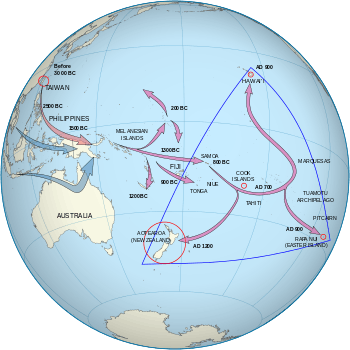Polynesians
| Total population | |
|---|---|
| 2,000,000[1] | |
| Regions with significant populations | |
| 816,144[2] | |
| 598,605+ | |
| 210,843 | |
| 5,682 | |
| Languages | |
| English and Polynesian languages (Tahitian, Samoan, Tongan, Māori, Hawaiian and others) | |
| Religion | |
| Christianity (96.1%)[3] and Polynesian mythology[4] | |
| Related ethnic groups | |
| Austronesian peoples | |
The Polynesian people consist of various ethnic groups that speak Polynesian languages, a branch of the Oceanic languages, and inhabit Polynesia. The native Polynesian people of New Zealand and Hawaii are minorities in their homelands.
Origins


Polynesians, including Samoans, Tongans, Niueans, Cook Islands Māori, Tahitian Mā'ohi, Hawaiian Māoli, Marquesans and New Zealand Māori, are a subset of the Austronesian peoples. They share the same origins as the indigenous peoples of maritime Southeast Asia, Madagascar, and Taiwan. This is supported by genetic,[5] linguistic,[6] and archaeological evidence.
The most widely accepted theory is that modern Austronesians originated from migrations out of Taiwan between 3000 and 1000 BC. However, Soares et al. (2008) have argued for an older pre-Holocene Sundaland origin within Island Southeast Asia (ISEA) based on mitochondrial DNA.[7]
Paternal Y chromosome analysis by Kayser et al. (2000) also showed that Polynesians have significant Melanesian genetic admixture.[8] However, a follow-up study by Kayser et al. (2008) discovered that only 21% of the Polynesian autosomal gene pool is of Melanesian origin, with the rest (79%) being of East Asian origin.[9] Another study by Friedlaender et al. (2008) also confirmed that Polynesians are closer genetically to Micronesians, Taiwanese Aborigines, and East Asians, than to Melanesians. The study concluded that Polynesians moved through Melanesia fairly rapidly, allowing only limited admixture between Austronesians and Melanesians.[10] Thus the high frequencies of B4a1a1 are the result of drift and represent the descendants of a few East Asian females.[11] The Polynesian population experienced a population bottleneck and genetic drift.[12]
Recent DNA studies show that the Atayal people from Taiwan and the Kankanaey people of the northern Philippines, who later mixed with Melanesians, were most probably among the original ancestors of modern Polynesians.[13][14]
People
.jpg)


The Polynesian peoples are shown below in their distinctive cultural groupings (populations of the larger groups are shown):
- Kanaka Maoli: Hawaii - 140,000 (including mixed 400,000)
- Maohi: Tahiti - 120,000 (including mixed: 250,000+)
- Cook Islands Māori: Cook Islands - 98,000+ (including New Zealand and Australian residents)
- Māori: New Zealand Aotearoa - 790,000 (including mixed)
- Moriori: Rēkohu Chatham Islands - 738 (2013 New Zealand Census)
- Rapanui: Easter Island - ~5,000 (including mixtures and those living in Chile)
- Austral Islanders: Austral Islands
- Mangareva: Gambier Islands
- Tuamotu: Tuamotu Archipelago
- Marquesas Islanders: Marquesas Islands
Western Polynesia
- Samoan: Samoa, American Samoa - 249,000 (from all countries: 400,000+)
- Tongan: Tonga - 104,000 (from all countries: 150,000+)
- Tuvaluan: Tuvalu - 10,000
- Tokelauan: Tokelau
- Niuean: Niue - ~20,000-25,000 (vast majority live in New Zealand)
- Uvea and Futuna:Wallis and Futuna
- Kapingamarangi and Nukuoro: The Federated States of Micronesia
- Nuguria, Nukumanu and Takuu: Papua New Guinea
- Anuta, Bellona, Ontong Java, Rennel, Sikaiana, Tikopia and Vaeakau-Taumako: Solomon Islands
- Emae, Makata, Mele (Erakoro, Eratapu), Aniwa, and Futuna: Vanuatu
- Fagauvea: Ouvéa (New Caledonia)
Estimated total population: 2 million[1]
See also
References
- 1 2 Polynesian men a global sports commodity - Stuff.co.nz
- ↑ Population Movement in the Pacific: A Perspective on Future Prospects. Wellington: New Zealand Department of Labour
- ↑ Christianity in its Global Context, 1970–2020 Society, Religion, and Mission, Center for the Study of Global Christianity
- ↑ Victoria University of Wellington, New view of Polynesian conversion to Christianity, 4 Apr 2014
- ↑ "Mitochondrial DNA Provides a Link between Polynesians and Indigenous Taiwanese". PLoS Biology. 3 (8): e281. 2005. doi:10.1371/journal.pbio.0030281.
- ↑ "Pacific People Spread From Taiwan, Language Evolution Study Shows". ScienceDaily. 27 January 2009. Retrieved 29 April 2010.
- ↑ Dr. Martin Richards. "Climate Change and Postglacial Human Dispersals in Southeast Asia". Oxford Journals. Retrieved 2010. Check date values in:
|access-date=(help) - ↑ M. Kayser, S. Brauer, G. Weiss, P.A. Underhill, L. Roewer, W. Schiefenhövel, and M. Stoneking, "Melanesian origin of Polynesian Y chromosomes," Current Biology, vol. 10, no. 20, pages 1237-1246 (19 Oct. 2000). See also correction in: Current Biology, vol. 11, no. 2, pages 141-142 (23 Jan. 2001).
- ↑ Kayser, Manfred; Lao, Oscar; Saar, Kathrin; Brauer, Silke; Wang, Xingyu; Nürnberg, Peter; Trent, Ronald J.; Stoneking, Mark (2008). "Genome-wide analysis indicates more Asian than Melanesian ancestry of Polynesians". The American Journal of Human Genetics. 82 (1): 194–198. doi:10.1016/j.ajhg.2007.09.010.
- ↑ Friedlaender, Jonathan S., Françoise R. Friedlaender, Floyd A. Reed, Kenneth K. Kidd, Judith R. Kidd, Geoffrey K. Chambers, Rodney A. Lea et al. "The genetic structure of Pacific Islanders." PLoS genetics 4, no. 1 (2008): e19.
- ↑ Assessing Y-chromosome Variation in the South Pacific Using Newly Detected, By Krista Erin Latham
- ↑ http://www.pnas.org/content/95/15/9047.full.pdf
- ↑ http://www.sciencemag.org/news/2016/10/game-changing-study-suggests-first-polynesians-voyaged-all-way-east-asia
- ↑ http://www.abc.net.au/news/2016-10-04/dna-reveals-lapita-ancestors-of-pacific-islanders-came-from-asia/7893100
External links
-
 Media related to People of Polynesia at Wikimedia Commons
Media related to People of Polynesia at Wikimedia Commons